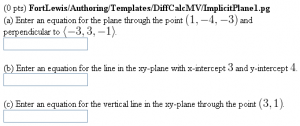ImplicitPlane1: Difference between revisions
(Created page with '<h2>Answer is an Equation for a Line or Plane</h2> 300px|thumb|right|Click to enlarge <p style="background-color:#f9f9f9;border:black solid 1px;paddi…') |
(add historical tag and give links to newer problems.) |
||
| (5 intermediate revisions by 3 users not shown) | |||
| Line 1: | Line 1: | ||
{{historical}} | |||
<p style="font-size: 120%;font-weight:bold">This problem has been replaced with [https://openwebwork.github.io/pg-docs/sample-problems/DiffCalcMV/ImplicitPlane.html a newer version of this problem]</p> | |||
<h2>Answer is an Equation for a Line or Plane</h2> | <h2>Answer is an Equation for a Line or Plane</h2> | ||
| Line 5: | Line 9: | ||
This PG code shows how to define an answer that is a line or plane. | This PG code shows how to define an answer that is a line or plane. | ||
</p> | </p> | ||
* | * File location in OPL: [https://github.com/openwebwork/webwork-open-problem-library/blob/master/OpenProblemLibrary/FortLewis/Authoring/Templates/DiffCalcMV/ImplicitPlane1.pg FortLewis/Authoring/Templates/DiffCalcMV/ImplicitPlane1.pg] | ||
* | * PGML location in OPL: [https://github.com/openwebwork/webwork-open-problem-library/blob/master/OpenProblemLibrary/FortLewis/Authoring/Templates/DiffCalcMV/ImplicitPlane1_PGML.pg FortLewis/Authoring/Templates/DiffCalcMV/ImplicitPlane1_PGML.pg] | ||
<br clear="all" /> | <br clear="all" /> | ||
| Line 43: | Line 47: | ||
loadMacros( | loadMacros( | ||
'PGstandard.pl', | |||
'MathObjects.pl', | |||
'parserImplicitPlane.pl', | |||
'parserVectorUtils.pl', | |||
'PGML.pl', | |||
'PGcourse.pl' | |||
); | ); | ||
| Line 56: | Line 61: | ||
<p> | <p> | ||
<b>Initialization:</b> | <b>Initialization:</b> | ||
* The <tt>parserVectorUtils.pl</tt> macro is used for the <tt>non_zero_point3D</tt> function below. | |||
* The <tt>parserImplicitPlane.pl</tt> macro includes the context and the <tt>ImplicitPlane</tt> function to parse and create implicit planes. | |||
</p> | </p> | ||
</td> | </td> | ||
| Line 66: | Line 74: | ||
<td style="background-color:#ffffdd;border:black 1px dashed;"> | <td style="background-color:#ffffdd;border:black 1px dashed;"> | ||
<pre> | <pre> | ||
Context( | Context('ImplicitPlane'); | ||
Context()->variables->are(x=>'Real',y=>'Real', z=> 'Real'); | |||
$A = non_zero_point3D(-5,5,1); | $A = non_zero_point3D(-5,5,1); | ||
| Line 72: | Line 81: | ||
$answer1 = ImplicitPlane($A,$N); | $answer1 = ImplicitPlane($A,$N); | ||
$answer2 = ImplicitPlane('4x+3y=12'); | |||
$answer3 = ImplicitPlane('x=3'); | |||
$answer2 = ImplicitPlane( | |||
$answer3 = ImplicitPlane( | |||
</pre> | </pre> | ||
</td> | </td> | ||
| Line 83: | Line 88: | ||
<p> | <p> | ||
<b>Setup:</b> | <b>Setup:</b> | ||
The first answer is a standard mulitivariable calculus question. There are several different ways to specify the input to <code>ImplicitPlane</code>, which are detailed in the [http://webwork.maa.org/pod/ | The first answer is a standard mulitivariable calculus question. There are several different ways to specify the input to <code>ImplicitPlane</code>, which are detailed in the [http://webwork.maa.org/pod/pg/macros/parserImplicitPlane.html POD documentation]. It is also possible to do some more complicated manipulations with the vectors and points, which is detailed in the [http://webwork.maa.org/wiki/ImplicitPlane problem techniques section]. | ||
</p> | </p> | ||
<p> | <p> | ||
| Line 96: | Line 101: | ||
<td style="background-color:#ffdddd;border:black 1px dashed;"> | <td style="background-color:#ffdddd;border:black 1px dashed;"> | ||
<pre> | <pre> | ||
BEGIN_PGML | |||
a. Enter an equation for the plane through the point [` [$A] `] and perpendicular to [` [$N] `]. | |||
the point | + [______________]{$answer1} | ||
b. Enter an equation for the line in the [` xy `]-plane with [` x `]-intercept [` 3 `] and [` y `]-intercept [` 4 `]. | |||
+ [______________]{$answer2} | |||
xy-plane with x-intercept | |||
y-intercept | |||
$ | |||
c. Enter an equation for the vertical line in the [` xy `]-plane through the point [` (3,1) `]. | |||
+ [______________]{$answer3} | |||
$ | |||
[@ helpLink('equation') @]* | |||
END_PGML | |||
</pre> | </pre> | ||
<td style="background-color:# | <td style="background-color:#ffcccc;padding:7px;"> | ||
<p> | <p> | ||
<b> | <b>Main Text:</b> | ||
</p> | </p> | ||
</td> | </td> | ||
</tr> | </tr> | ||
<tr valign="top"> | <tr valign="top"> | ||
<td style="background-color:#ddddff;border:black 1px dashed;"> | <td style="background-color:#ddddff;border:black 1px dashed;"> | ||
<pre> | <pre> | ||
BEGIN_PGML_SOLUTION | |||
Solution explanation goes here. | Solution explanation goes here. | ||
END_PGML_SOLUTION</pre> | |||
</pre> | |||
<td style="background-color:#ddddff;padding:7px;"> | <td style="background-color:#ddddff;padding:7px;"> | ||
<p> | <p> | ||
| Line 177: | Line 144: | ||
[[Category:Top]] | [[Category:Top]] | ||
[[Category: | [[Category:Sample Problems]] | ||
[[Category:Subject Area Templates]] | |||
Latest revision as of 10:30, 18 July 2023
This problem has been replaced with a newer version of this problem
Answer is an Equation for a Line or Plane

This PG code shows how to define an answer that is a line or plane.
- File location in OPL: FortLewis/Authoring/Templates/DiffCalcMV/ImplicitPlane1.pg
- PGML location in OPL: FortLewis/Authoring/Templates/DiffCalcMV/ImplicitPlane1_PGML.pg
| PG problem file | Explanation |
|---|---|
|
Problem tagging: |
|
DOCUMENT(); loadMacros( 'PGstandard.pl', 'MathObjects.pl', 'parserImplicitPlane.pl', 'parserVectorUtils.pl', 'PGML.pl', 'PGcourse.pl' ); TEXT(beginproblem()); |
Initialization:
|
Context('ImplicitPlane');
Context()->variables->are(x=>'Real',y=>'Real', z=> 'Real');
$A = non_zero_point3D(-5,5,1);
$N = non_zero_vector3D(-5,5,1);
$answer1 = ImplicitPlane($A,$N);
$answer2 = ImplicitPlane('4x+3y=12');
$answer3 = ImplicitPlane('x=3');
|
Setup:
The first answer is a standard mulitivariable calculus question. There are several different ways to specify the input to
When the |
BEGIN_PGML
a. Enter an equation for the plane through the point [` [$A] `] and perpendicular to [` [$N] `].
+ [______________]{$answer1}
b. Enter an equation for the line in the [` xy `]-plane with [` x `]-intercept [` 3 `] and [` y `]-intercept [` 4 `].
+ [______________]{$answer2}
c. Enter an equation for the vertical line in the [` xy `]-plane through the point [` (3,1) `].
+ [______________]{$answer3}
[@ helpLink('equation') @]*
END_PGML
|
Main Text: |
BEGIN_PGML_SOLUTION Solution explanation goes here. END_PGML_SOLUTION |
Solution: |